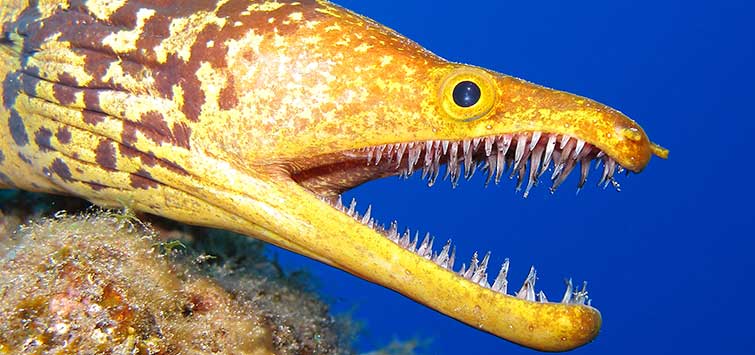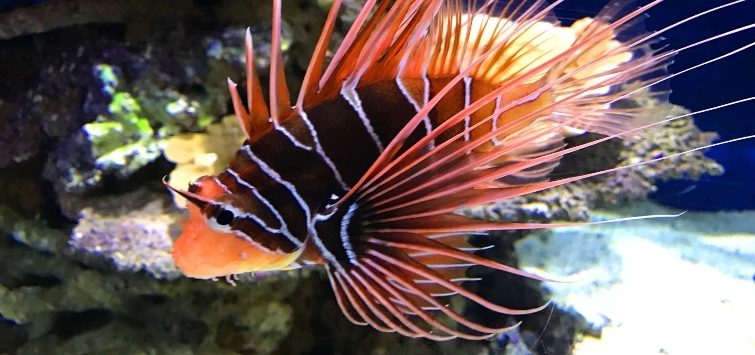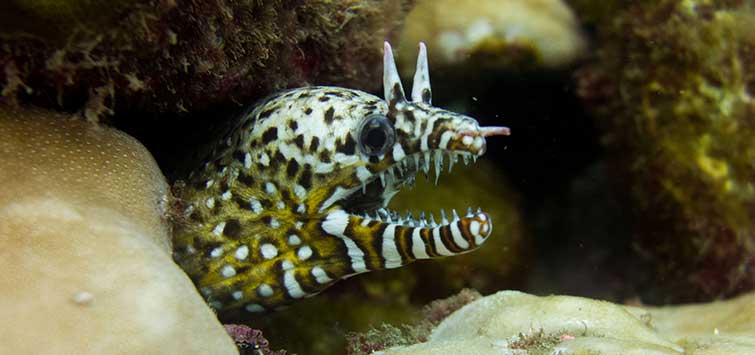Moray Eels Bite-- But Are They Poisonous?
Author: Marco Lichtenberger
Moray eels have been known to snap at their keepers, so learning about the prevention and treatment of their bites is essential for those who want to safely house these creatures in the home aquarium.
Watch Out for Eel Bites
Without a doubt moray eels are among the fish you’d call oddballs if they were from fresh water. Most specimens usually hide their long bodies in narrow gaps and holes all day, but when they leave their hiding spots for food or explorative purposes they are definitely eye-catchers. Not only will they grab our attention, but sometimes if given the possibility they will also grab our fingers, hands, and arms!
In the last moray-related article I wrote I could not give any information based on personal experience with regards to moray bites. Well, things have changed since then, and I had an unfortunate meeting with the teeth of one of my morays. Accordingly, after the “wound” was treated, I searched literature for information on moray toxins and bites and, aside from my own little experience, I came across several reports of hobbyists, as well as scientific and toxicological studies on substances from morays.
State of Knowledge
There is quite a divergence in published books for hobbyists with regard to the toxicity of moray eels. Most interestingly there is also a divergence with regard to the language these books were written in. Searching German books and online sources, one often stumbles upon the following statements, translated here. “Moray eels are poisonous. Among all moray eels five species even can give a deadly bite. One of them is the Mediterranean moray Muraena helena.” English sources often state that moray eels are not poisonous. Comparing these statements to scientific literature, both have to be considered inaccurate.
Mucous Toxins Produced by Morays
Studies as well as personal reports confirm that the bite of a moray eel can be much more painful than the bite of other predatory fishes of similar size. This hardly can be explained by a “pulling back effect,” which means that one automatically pulls back a bitten limb and thus increases the wound by driving the moray eel’s teeth through the flesh forcefully. This happens with other fishes, too. Secondary infections also fail to explain strong pain immediately after a moray bite. Such infections can likely occur if wounds are not treated properly, but will need several hours to spread. In addition to the pain, wounds from moray bites usually bleed heavily.
Toxins Found
It was suggested that bleeding and pain are related to a toxin in the slime coat of the skin and the mucous of the mouth. And truly, the mucous of moray eels was analyzed, and not just one, but several toxic substances were found. One of these substances is hemagglutinin. This is a glycoprotein that causes red blood cells to clump. Another toxin found in the mucous coat of moray eel was shown to be haemolytic, meaning the toxin destroys red blood cells. Since these toxins are related to glands in the skin of the eel, they are also called crinotoxins. The observations summarized here were made on the moray eel Gymnothorax nudivomer, also known as starry moray or yellow-mouth moray and formerly placed in the genus Lycodontis.
Closer examinations showed that the yellow-mouth morays had specific club-shaped cells in their thick (up to 2-mm) skin that produce these toxins. So in contrast to many other toxic marine animals (e.g., pufferfish) that ingest poisonous critters and store the ingested toxins in their own tissue, morays are capable of producing crinotoxins themselves. Those club-shaped cells have not only been found in the yellow-mouth moray, but also in many other species.
It is possible that the majority of all of the about 200 moray eel species can produce toxins. However, this has not been subject to scientific research yet. What is known so far is that the number and distribution of the club cells varies among species. In addition, it has been suggested that moray eels with serrate teeth (e.g., G. nudivomer, G. albimarginatus, G. chlamydatus, G. ocellatus) can transfer the most mucous into the wounds, thus producing the most painful bites.
Are Crinotoxins Dangerous?
To this point it is believed that the crinotoxins of morays are not very dangerous and only lead to increased pain and bleeding. However, allergic reactions may be possible and are just one more reason you don’t want to be bitten by a moray eel. Those crinotoxins additionally support two general rules of tank maintenance: don’t reach into a tank with wounds on your hands, and don’t touch your moray eel.
Blood Toxins
Moray eels, as well as many other eel-like fish of the order Aguilliformes, have toxic proteins in their blood. They are usually referred to as ichthyotoxins, which simply means “fish poisons.” They are among the oldest toxic substances from marine critters known to mankind. Fishermen in general are aware of the fact that certain fishes have to be heated above 75°C (167°F) to destroy the toxins. Consequently, making moray eel sushi is not a good idea. Ichthyotoxin poisoning can lead to spasms and heavy breathing. These substances are also haemolytic and should not touch your eyes, mouth, or open wounds. Bleeding moray eels should be handled carefully.
Tissue Toxins
Moray eels, like many other predatory fishes, carry the possibility of storing specific toxins in their flesh/organs. The two most prominent substances are ciguatoxin and maitotoxin. These toxins cannot be destroyed by heating the fish to 75°C. They can lead to a type of food poisoning known as ciguatera. It’s good that these substances are not transferred by bites.
Ciguatoxin
Ciguatoxin is not produced by moray eels themselves, but by dinoflagellates (e.g., Gambierdiscus toxicus). These are microscopic protozoans often capable of photosynthesis. Some of these planktonic or sessile organisms produce ciguatoxin and are at the lower end of the food chain. Sessile species are eaten, and floating species are filtered by all kinds of filter feeders—clams for example. This way the toxin is enriched from step to step in the food chain. Especially large specimens of moray eel such as the giant moray Gymnothorax javanicus can enrich dangerously toxic amounts of ciguatoxin.
Ciguatoxin is a neurotoxin—it inhibits the sodium channels needed for signal transmission in the nerves. Symptoms are sickness, spasms, skin irritations, and partial paralysis. It is not unlike the saltwater puffer toxin tetrodotoxin and the freshwater puffer toxin saxitoxin—luckily it is slightly less effective and less concentrated. Ciguatoxin poisoning is not lethal in more than 99 percent of all reported cases, but it is often recommended not to eat moray eels larger than 1½ meters (5 feet), because the actual amount of stored poison in morays of larger size is unpredictable.
Secondary Infections
While the effects of the moray eel crinotoxins are currently considered minimal, and it is thought that the blood and tissue toxins can hardly affect you when bitten, secondary infections are a serious threat to your health.
Moray eels don’t have pectoral fins or hands. Even if they could be trained to use a toothbrush, they’d have major problems with cleaning the numerous spaces between their multi-serial teeth. Rotting pieces of food provide a perfect environment for nasty bacteria, which would love to be transferred to a fresh piece of meat (you and me) by a bite. Among them is the infamous Vibrio, which can cause septicemia. These bacteria have been cultured from captive moray eel.
Although there don’t seem to have been any fatal cases reported from moray bites, there have been fatalities caused by Vibrio infections from other sources. Another infamous hitchhiker you can get from a moray eel is Pseudomonas.
Cleaning the Wound
The most important thing to do when bitten by a pet moray is to clean the wound with painstaking care. Hold your hand under the tap and thoroughly wash out the wound. Disinfect the wound. Be sure to visit a doctor if you see your wound is heavily swelling or turning red. Septicemia is no fun and can put you in the hospital fast.
Medical Care
Larger wounds can be dangerous due to the loss of tissue and blood. They will need medical care, and if you feel you can’t cope with your wound (no matter what the size), get yourself to a doctor or ask someone to give you a ride if you feel dizzy. Make an emergency call if necessary. If you are losing lots of blood because some larger blood vessel has been cut open, the affected limb may need to be ligatured until further help arrives.
Bite Prevention
It can be concluded that pet moray bites are far from being inevitably lethal, but they are nasty, potentially dangerous, and should be avoided as much as possible. Some general rules can help you and your moray eel to get along so you can truly enjoy your very special pet.
No Hand-Feeding
It may be quite an attraction to hand-feed your moray in front of your friends, and it may also seem like this could somehow improve your relationship with your pet, but in general feeding by hand is the most obvious way to risk being bitten by a moray eel.
Hand-feeding is widely spread among hobbyists, and in fact it can go well for many years, but there is no guarantee that you will not be bitten. Even if your specimen seems to take food very carefully out of your hand, this can change from one day to another. Especially risky are the “tame” snowflake eels Echidna nebulosa, which are known to suddenly change their minds with regard to feeding, and also with regard to considering their tankmates as potential food.
No Large Species
It is one thing to be bitten by a one-foot juvenile snowflake eel, which only has quite small teeth, but being bitten by a 5-foot green moray Gymnothorax funebris may be a different experience. Moray eels of that size are capable of tearing out large pieces of flesh from your arms, and they may even rip off entire fingers and mutilate their careless owners. Therefore such animals should only be kept by people who really know what they are doing (e.g. staff of public aquaria or insanely dedicated enthusiasts).
Among these large and dangerous species seen in the trade is the tessellated or honeycomb moray eel Gymnothorax favagineus, as well as the green moray eel Gymnothorax funebris. The common name “giant moray” for Gymnothorax javanicus is self explanatory. WetWebMedia.com lists some more potentially dangerous moray eel species not suited for the average fishkeeper.
All species (except zebra, chain-link, and ribbon moray eels) above 3 feet can be considered difficult with regard to the wounds they potentially can afflict. Some of the smaller species—especially the ones with long and curved teeth, such as the various dragon moray eels—also acquire specific attention.
Use Tools for Maintenance
One of the basic rules of fishkeeping is to keep your hands out of the tank as much as possible. Usually this is meant to avoid the possible input of non-beneficial substances such as oils, fats, and soap. In the case of a moray eel tank, it also has a bearing upon your own safety.
Numerous long tools are available for almost anything that needs to be done in a tank. Feeding sticks, long pliers, tweezers, and other items are widely available in the shops. This arsenal can be extended with basic DIY abilities and a little imagination.
If you really need to grab into a moray tank with your hands, be sure the lights are on, know where your moray eels are, and possibly have a net available to keep their heads away from your hands. An additional person can help you by constantly reporting what the moray eel is doing.
Never Stop Paying Attention
This is probably the hardest rule to stick to. Maintaining tanks for months and years leads to a certain routine that drains away the attention paid to the individual tasks involved. This is widely known among keepers of venomous snakes, who often fear forgetting to lock their pet’s quarters due to routine.
My own moray eel biting experience was also caused by a lack of attention. I got up at 6:30 a.m. and just had a short look at one of the tanks. One of the new Sarcophyton cuttings had left its place, and not even half-awake I grabbed into the tank to put it back and ended up with a moray eel on my little finger. The moray released its bite quickly and hid the entire day. It was very shy for a few days—I guess this was not a nice experience for the moray eel either.
I wasn’t paying attention and did not use a tool, so I was bitten. The positive thing is that I always pay attention now and likely will always do so in the future—I learned my lesson!
Final Thoughts
In summary, moray eels are in fact poisonous in several ways, including when they bite. The exact toxicity of their bites is unknown so far and empirically considered rather low. Secondary infections and massive loss of tissue and blood from the bites of large specimens probably constitute a greater danger.
However, just because they can bite doesn’t mean that moderately sized moray eels cannot be wonderful aquarium pets. It’s just a reason for being careful and paying attention, two actions beneficial for any tank, be it with a moray eel or not.
See the full article on TFH Digital http://www.tfhdigital.com/tfh/200709/#pg118

.png?h=595&iar=0&w=2781&hash=5FD5E69473BCC22199FBFA2FB71B6033)



